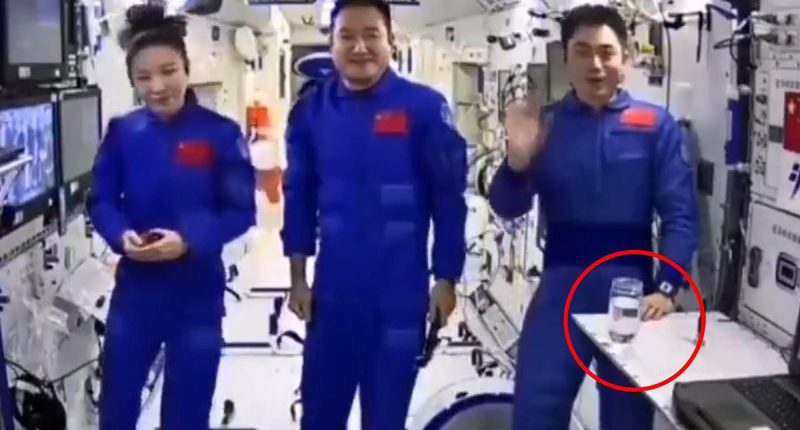Share this @internewscast.com
From the moon landings to Katy Perry’s trip to space, conspiracy theorists are obsessed with proving that humans have never really left the planet.
Now, internet-dwelling theorists have latched on to a strange new video which shows a glass of water on China’s Tiangong Space Station.
In the video, an open glass of water appears to stand, undisturbed, on a table – despite the microgravity environment.
The clip has sent conspiracy theorists into a frenzy, with one claiming that the glass seemed to be ‘fully subjected to gravity’.
Social media users’ suspicions stem from the fact that videos from space typically show water floating freely in spheres rather than inside containers.
This has led many people to assume that water could not possibly stay inside an open container outside of Earth’s gravitational pull.
On X, one confused commenter wrote: ‘Call me crazy but if I was orbiting the Earth at 17,500 mph in Zero Gravity surrounded by complex computers…I probably wouldn’t risk an unconcealed glass of water resting on the table.’
Despite the widespread histeria, there’s a simple explanation for the glass of water.

Conspiracy theories have ignited after a video showed an open glass of water sitting on a table aboard the Chinese Tiangong Space Station

An online conspiracy theorist shared the image, questioning why the taikonauts would risk having an open container of water so close to a computer

Commenters were certain that the water could not stay in the glass in microgravity and that it should be floating away
Despite their beliefs that humans have not been to space, many conspiracy theorists were certain they knew what would happen to an open glass of water in microgravity.
‘The water wouldn’t stay in the glass. It would be floating,’ one user claimed.
Another wrote: ‘The water wouldn’t stay in the glass. It would be floating.’
And one added: ‘That water should be floating around like bubbles.’
For many social media users, this led to the conclusion that the video must have been filmed within the pull of Earth’s gravity rather than out in orbit.
‘Apparently they are not in zero gravity as water stays in the glass,’ one commenter wrote.
Another chimed in: ‘Yep, it’s fake. They are not in zero gravity.
One asked: ‘So, they’re not in space?’

Social media users were baffled as to how the water could stay in the glass while orbiting onboard the Tiangong space station (pictured)

The presence of the mysterious water glass was enough to convince some commenters that the video had been faked

One commenter asked: ‘So, they’re not in space?’

One conspiracy theorist ranted that the whole space station was ‘an act’ produced by ‘walking on an uneven surface’
The situation was not helped when Elon Musk’s AI, Grok, started to offer misleading information in response to user’s questioning.
In one response the AI declared: ‘Yes, water would float out of a glass in a space station due to microgravity.’
Meanwhile, other commenters were launched even deeper into the world of conspiracy theories as they puzzled over why the astronauts might not really be in space.
A commenter fumed: ‘This is ridiculous. The water wouldn’t stay in the glass. Why do they insist in surrounding us in a sea of lies?’
Another wrote: ‘They are not in zero G it’s an act. They are walking on an uneven surface to create a slight floating effect by they are still grounded.’
And one conspiratorially-minded commenter added: ‘At this stage I think they are doing it on purpose, to wake people up. You can’t tell them, you have to show them.’
However, there is a rational explanation for everything that can be seen in the video.
The most important thing to note is that this is exactly how an open glass of water in microgravity should behave.

In reality, this glass was prepared for a special broadcast called Tiangong classroom in which the taikonauts show science experiments to children back on Earth. Here, they are showing how buoyancy works differently in space by placing a ping-pong ball in water
Jordan Bimm, a postdoctoral researcher and space historian at the University of Chicago, told AP: ‘Water molecules like to stick to glass and also to other water molecules more than they like to disperse in the air.
‘So if there is no external force, water remains in “clumps” in the weightless environment, and in this case inside the glass.’
Water is made of slightly positive hydrogen atoms and slightly negative oxygen atoms, which pull towards each other like opposite ends of a magnet.
This gives water a very strong surface tension which makes it stick to the surface and hold its shape despite outside forces.
Mr Bimm adds that this ‘also works to help maintain the static shape and presents the illusion of how water would act on the ground.’
So, when you place water inside a glass in zero gravity it will stick to the inside walls and look just like it would on Earth.
In fact, as European Space Agency (ESA) Samantha Cristoforetti demonstrated in a video, it can be almost impossible to get water out of an open container in microgravity.
This is why astronauts need to use squeezable bags and straws to drink.

As this demonstration shows, water won’t escape from the glass even if the container is disturbed

A separate video, shared by the China Manned Space Agency, shows how the crew had to carefully fill the glass using a straw. The caption reads: ‘Preparing for class in space is not easy!’
As for why there would be an open glass of water on Tiangong despite the apparent safety risk, this is clear from the context of the video.
As the video clearly shows, this clip has been taken from a broadcast called ‘Tiangong class’ – a project in which Chinese taikonauts demonstrate science experiments to children back on Earth.
As the full broadcast reveals, this glass was being used in a demonstration to show how buoyancy works differently in space by suspending a ping-pong ball in water.
A separate video posted to the Chinese social media platform Weibo, shows one of the astronauts painstakingly filling the glass using a straw before carefully setting it on the table with velcro.
These details were not lost on some astute commenters, with one writing: ‘That’s called physics and that’s surface tension that allows the water to stay as it is in the glass, the glass itself is fixed in place.
Another joked: ‘It’s not like you couldn’t just spend five minutes researching this stuff.’






